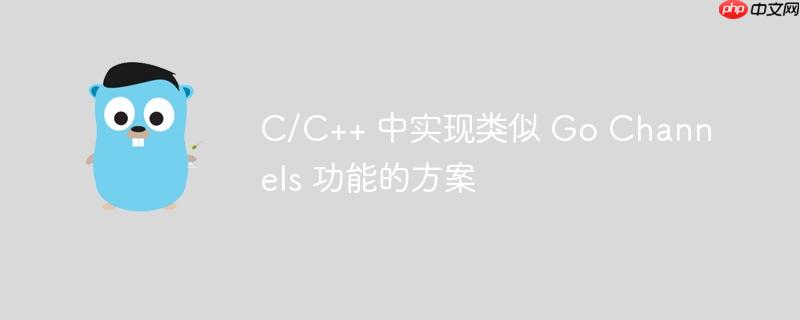
在构建高性能多线程网络服务器时,线程间的数据传递是一个关键问题。Go 语言的 Channels 提供了一种简洁而强大的机制来处理这个问题。虽然 C/C++ 没有内置 Channels,但我们可以通过一些方法来实现类似的功能。本文将探讨如何使用线程池以及现有的 C++ 库来解决线程间数据传递的问题。
线程池是一种常用的并发编程模式,它通过预先创建一组线程,避免了频繁创建和销毁线程的开销。在网络服务器中,主线程负责监听连接和接收数据,然后将任务提交给线程池中的工作线程处理。
工作原理:
示例代码(伪代码):
立即学习“C++免费学习笔记(深入)”;
// 任务对象
struct Task {
int client_socket;
std::string data;
};
// 任务队列 (可以使用线程安全的队列)
std::queue<Task> task_queue;
std::mutex task_queue_mutex;
std::condition_variable task_queue_cv;
// 工作线程函数
void worker_thread() {
while (true) {
std::unique_lock<std::mutex> lock(task_queue_mutex);
task_queue_cv.wait(lock, []{ return !task_queue.empty(); }); // 等待任务
Task task = task_queue.front();
task_queue.pop();
lock.unlock();
// 处理任务
process_data(task.client_socket, task.data);
}
}
// 主线程函数
void main_thread() {
// 创建线程池
std::vector<std::thread> thread_pool;
for (int i = 0; i < NUM_THREADS; ++i) {
thread_pool.emplace_back(worker_thread);
}
// 监听端口,接收连接
while (true) {
int client_socket = accept_connection();
std::string data = receive_data(client_socket);
// 创建任务对象
Task task = {client_socket, data};
// 将任务放入任务队列
std::lock_guard<std::mutex> lock(task_queue_mutex);
task_queue.push(task);
task_queue_cv.notify_one(); // 唤醒一个工作线程
}
// 等待所有线程结束 (实际应用中需要更优雅的关闭方式)
for (auto& thread : thread_pool) {
thread.join();
}
}注意事项:
ACE (Adaptive Communication Environment) 和 Poco C++ Libraries 是两个强大的 C++ 库,它们提供了丰富的组件和工具,可以简化网络编程和并发编程的开发。
ACE:

一个类似淘宝助理、ebay助理的客户端程序,用来方便的在本地处理商店数据,并能够在本地商店、网上商店和第三方平台之间实现数据上传下载功能的工具。功能说明如下:1.连接本地商店:您可以使用ShopEx助理连接一个本地安装的商店系统,这样就可以使用助理对本地商店的商品数据进行编辑等操作,并且数据也将存放在本地商店数据库中。默认是选择“本地未安装商店”,本地还未安
 0
0

ACE 是一个面向对象的框架,提供了用于开发高性能、分布式和并发应用程序的组件。它包含了线程池、消息队列、事件处理等功能,可以方便地构建复杂的网络应用。
Poco:
Poco 是一个跨平台的 C++ 类库集合,提供了网络、数据库、XML、JSON 等方面的支持。Poco 也提供了线程池和消息队列等组件,可以用于实现线程间通信。
使用示例 (Poco):
#include "Poco/ThreadPool.h"
#include "Poco/Runnable.h"
#include "Poco/Thread.h"
#include <iostream>
class MyTask : public Poco::Runnable {
public:
MyTask(int id) : _id(id) {}
void run() {
std::cout << "Task " << _id << " running in thread " << Poco::Thread::current()->name() << std::endl;
Poco::Thread::sleep(1000); // 模拟耗时操作
std::cout << "Task " << _id << " finished" << std::endl;
}
private:
int _id;
};
int main() {
Poco::ThreadPool& pool = Poco::ThreadPool::defaultPool();
pool.setCapacity(4); // 设置最大线程数
pool.setMaxQueueSize(10); // 设置最大任务队列长度
for (int i = 0; i < 10; ++i) {
pool.start(new MyTask(i)); // 提交任务
}
pool.joinAll(); // 等待所有任务完成
return 0;
}总结:
通过使用线程池和现有的 C++ 库(如 ACE 和 Poco),可以有效地实现类似 Go Channels 的线程间通信机制,构建高性能的多线程网络服务器。选择合适的方案取决于具体的应用场景和需求。对于简单的应用,可以手动实现线程池和任务队列。对于复杂的应用,建议使用 ACE 或 Poco 等成熟的库,可以节省开发时间和精力,并提高代码的可靠性和可维护性。
以上就是C/C++ 中实现类似 Go Channels 功能的方案的详细内容,更多请关注php中文网其它相关文章!

每个人都需要一台速度更快、更稳定的 PC。随着时间的推移,垃圾文件、旧注册表数据和不必要的后台进程会占用资源并降低性能。幸运的是,许多工具可以让 Windows 保持平稳运行。

Copyright 2014-2025 https://www.php.cn/ All Rights Reserved | php.cn | 湘ICP备2023035733号